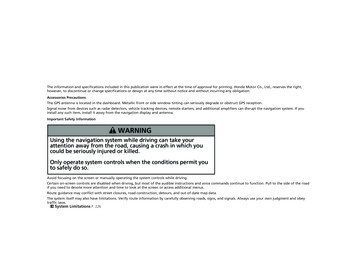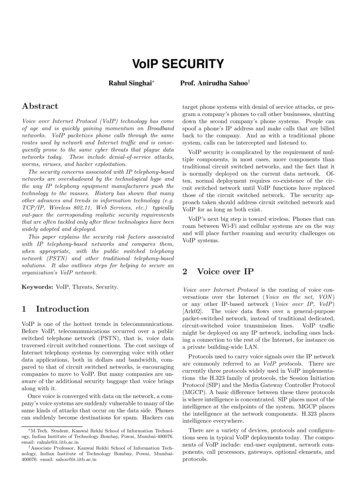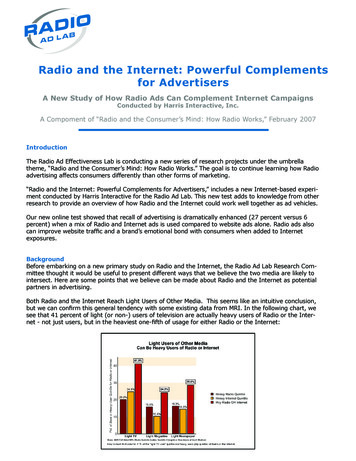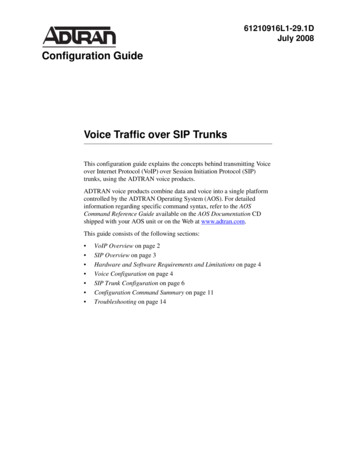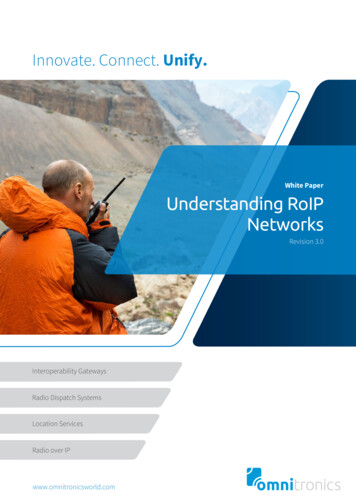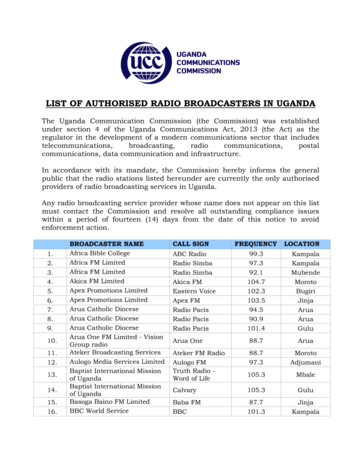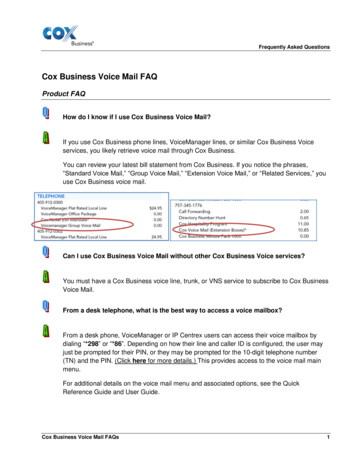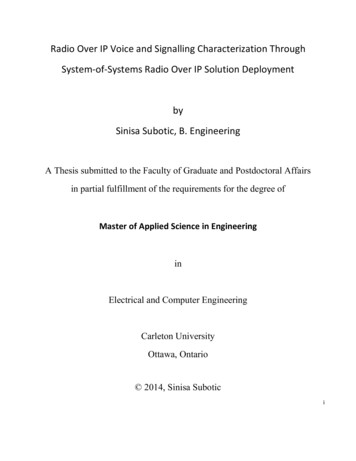
Transcription
Radio Over IP Voice and Signalling Characterization ThroughSystem-of-Systems Radio Over IP Solution DeploymentbySinisa Subotic, B. EngineeringA Thesis submitted to the Faculty of Graduate and Postdoctoral Affairsin partial fulfillment of the requirements for the degree ofMaster of Applied Science in EngineeringinElectrical and Computer EngineeringCarleton UniversityOttawa, Ontario 2014, Sinisa Subotici
AbstractThe focus of the thesis is on the characterizing Radio over IP voice and signalling delay, availability andvoice quality by deploying Radio over IP (RoIP) System-of-Systems solution over large distances. System-of-Systems RoIP solution interfaces various mobile radio systems over multiple third party WideArea Networks (WANs) based on Multiprotocol Label Switching Internet Protocol (MPLS IP) links toenable different departments such as Police, Military, Fire, Ambulance, Oil, Correctional Services, Forestry, Mining and etc. to communicate using their existing mobile radios. This thesis focuses on 4 majorparts. The first part identifies various mobile radio systems and interfaces to extract and convert radiosignaling and voice into the IP packets. The second, researches various interoperability managementsystems (servers/applications) to interconnect various mobile radio clients (agencies and departments)through the voice patches/conferences. The third focuses on the RoIP System-of-Systems solution deployment, testing under real-world condition using both unicast and multicast enabled networks, developing baseline characteristics such as Codecs, Delay, Jitter, Packet Loss, for secure and reliable communication over the third party WAN (MPLS IP backbone). The fourth focuses on RoIP System-ofSystems architectures and their performances when deployed over large distances and multiple third party WAN networks. The fourth primarily focuses on the systems latency characterisation, availability andvoice quality. This thesis is the first one to examine radio over IP interoperability into a great level ofdetails and provide a good foundation in understanding where interoperability would work and wherenot by characterizing major delay contributors in the overall System-of-Systems RoIP solution, fromtechnology perspective. In this thesis RoIP communication over large distances has achieved 99.99%99.999% availability and audio quality was found to be loud and clear 5/5 (signal strength 5/clarity 5).ii
AcknowledgementsFirst and foremost, I would like to thank you to my supervisor, Dr. Chang Cheng Huang for his support, guidance,patience in conducting research. Also my special thanks goes to my Manager Mark Penney who supported myresearch to be aligned with my work to solve problems that many different agencies and departments such aspolice, military, fire, ambulance, oil, correctional services, forestry, mining and etc. experience due to thelack of Mobile Radio Interoperability.Next, I would like to thank to my colleagues Dale Capling, Werner Brunkee and Robert Nadeau in providingassistance to obtain RoIP testing data such as inherent delay of various radio systems and RoIP delaycharacterisation over the large distances. Also I would like to thank to my colleague Sebastien Leclerc for RoIPsolution field deployment assistance and for his general support.Lastly, I would like to dedicate this Thesis in loving memory of my uncles Momcilo Subotic and Jovo Subotic,both whom passed away during the course of this paper. Last but not least, I would like to thank my family andfriends.iii
Table of ContentsTable of Contents . ivList of Figures . viiList of Tables . ixList of Acronyms . xChapter 1: Introduction .11.1 System-of-Systems Radio over IP (RoIP) interoperability solution .21.2 Motivation .31.3 Approach .71.4 Contributions.91.5 Outline of this Thesis . 10Chapter 2: Background . 112.1 Analog and Digital (Conventional and Trunking) Mobile Radio Systems . 112.1.1 Analog Mobile Radio Systems. 122.1.2 Digital Mobile Radio Systems . 142.1.3 P25 Digital Radio system. 152.1.4 Conventional and Trunking Mobile Radio System . 172.1.4.1 Conventional Mobile Radio Systems . 172.1.4.2 Trunking Mobile Radio System . 182.2 Interface between Radio Systems and IP backbone . 202.2.1T1 Interface. 222.2.2Ear and Mouth /Earth and Magneto (E&M) analog interface . 222.2.3Trunked Analog Gateway (TAG) . 252.3 Connection trunk connections (unicast/multicast). 262.3.1 Unicast point-to-point connection trunks . 262.3.2 Multicast over Unicast to Multicast (M1:U12:M2) configuration . 282.4 GRE Tunnels with IPsec encryption . 292.4.1 Generic Routing Encapsulation (GRE) Tunnels . 292.4.2 IPsec . 30iv
2.5 Baseline characteristics . 312.6 Quality of Service (QoS) . 342.6.1 QoS within the Local Area Network (LAN) . 372.6.2 QoS over the Wide Area Network (WAN). 372.7 Application Servers . 392.7.1 IP Interoperability and Collaboration System (IPICS) . 392.7.2 Wave Interoperability platform . 41Chapter 3: System-of-Systems Radio over IP Network Characterization . 433.1 Connection setup, transport protocol, port number and compression codec . 443.2 Overview of the test setup to characterize the network . 453.3 Overview of baseline requirements bandwidth, latency, jitter, and packet loss for Radio over IPdeployment . 503.4 Overview of radio features and network change impact on the radio features. . 56Chapter 4: System-of-Systems RoIP deployment examples and Experimental results . 584.1 System-of-System RoIP deployment examples. 584.1.1 System-of-Systems RoIP deployment architecture I - (one agency-multiple departments) . 594.1.1.1 Test Strategy . 614.1.1.2 Test Results . 614.1.1.2.1 Delay of the IP core at the hub site . 614.1.1.2.2 Delay between a spoke site and hub site . 644.1.1.2.3 Packet loss and voice quality . 744.1.1.3 System-of-Systems RoIP architecture I - Analysis. 784.1.2 System-of-Systems RoIP deployment architecture II (two agencies - multiple departments) . 854.1.2.1 Test Strategy . 864.1.2.2 Test Results . 874.1.2.2.1 Inter-agency hub-to-hub delay. 874.1.2.2.2 Inter agency delay between agency X LMR gateways and agency Y hub (core) site . 904.1.2.2.3 Network delay between agency Y departments and agency Y hub . 914.1.2.2.4 Inter-agency delay between departments (LMR gateway-to-LMR gateway) . 914.1.2.2.5 Inherent latency of radio systems in agency Y . 92v
4.1.2.2.6 End-to-End latency (user-to-user) . 924.1.2.2.7 Inter-agency voice quality . 944.1.2.2.8 System-of-Systems RoIP availability (packet loss). 944.1.2.3 System-of-Systems Architecture II - Analysis . 974.1.3 Validation and comparison . 103Chapter 5: Conclusions and Future Work. 1067.1 Summary . 1067.2 Future Directions. 109References . 110Appendix A -System-of-Systems RoIP deployment architecture I - complete test results . 118Appendix A1 – Inherent latency of the radio systems . 118Appendix A2 – Delay between spoke sites (LMR gateways) and the hub (core) site . 122Appendix A3 - End-to-end delay (user-to-user, a real life scenario). 125Appendix B - System-of-Systems RoIP deployment architecture II - complete test results . 128Appendix B1 – Inter-agency hub-to-hub delay . 128Appendix B2 - Inherent latency of radio systems in agency Y . 130Appendix B3 - End-to-End latency (user-to-user) . 132vi
List of FiguresFigure 1.1: Bandwidth usage: Multicast vs. Unicast IP [31] .3Figure 1.2: Radio spectrum allocation in Canada [47] .4Figure 1.3: Radio spectrum allocation in United States [48].5Figure 2.1: Analog mode overview . 13Figure 2.2: High level overview of analog radio voice communication . 13Figure 2.3: High level overview of digital radio voice communication . 14Figure 2.4: P25 Radio system architecture . 16Figure 2.5: E&M VIC3-2E&M pinouts [16] . 24Figure 2.6: M1:U12:M2 Connection trunks . 29Figure 2.7: IPv4 Header [35] . 34Figure 2.8: IPv4 TOS Byte [35] . 35Figure 2.9: Differentiated Service Codepoint (DSCP) [35] . 36Figure 2.10: Figure2.10: Cisco IPICS interoperability platform [28] . 40Figure 2.11: Wave Interoperability platform [31] . 42Figure 3.1: Phase I: Lab test setup point-to-point trunks . 45Figure 3.2: Phase I: Lab test setup point-to-point trunks over GRE/IPSEC Tunnel . 45Figure 3.3: Phase II: Lab test setup point-to-point trunks over simulated Wide Area Network (WAN) . 46Figure 3.4: Phase III: Field test setup point-to-point trunks over third party (BELL/Telus) WANs . 47Figure 3.5: Phase IV: Lab test setup - M1:U12:M2 trunks over simulated WAN . 48Figure 3.6: Voice traffic packet loss over WAN (MPLS IP circuits) without and with QoS enabled . 55Figure 3.7: DTMF -Tones . 57Figure 4.1: System-of-Systems RoIP architecture I (simulating agency X with multiple departments) . 59Figure 4.2: Delay measurement test setup at the HUB site . 62vii
Figure 4.3: Radio inherent delay - test setup . 64Figure 4.4: Inherent radio system latency: PTT to RX and audio latency . 67Figure 4.5: Spoke site to hub site delay (traffic looped with soft patch) . 69Figure 4.6: Spoke site to hub site delay (traffic looped with loopback cable) . 71Figure 4.7: End-to-End audio latency test setup. 73Figure 4.8: Audacity and silence finder features . 75Figure 4.9: 24 hr audio recording and analysis test setup. 75Figure 4.10: System availability – 24hrs continuous audio test for 10 consecutive days . 76Figure 4.11: Interoperability call flow - one agency/multiple departments . 78Figure 4.12: System-of-Systems RoIP architecture 2 (simulating interoperability between agency X and agencyY) . 85Figure 4.13: M1:U12:M2 Connection trunks and radio channel mapping using patch/conference4.1.2.1 TestStrategy . 86Figure 4.14: Test setup to determine inter-agency (hub-to-hub) delay . 88Figure 4.15: Inter-agency availability test setup . 95Figure 4.16: System availability – 24hrs continuous audio test for 10 consecutive days . 96Figure 4.17: Inter-agency interoperability call flow and delay metric . 97Figure 4.18: Proposed multicast service reflection test setup to eliminate M1:U12:M2 delay . 99viii
List of TablesTable 2.1: Cisco E/M Interface 2-wire and 4 wire operation - Type I, II, III, IV and V mapping . 25Table 3.1: Baseline characteristics - Analog radio-to-Analog radio . 51Table 3.2: Baseline characteristics - P25 Digital radio-to-P25 Digital Radio . 51Table 3.3: Baseline characteristics - P25 Trunking . 52Table 4.1: Physical loopback cable pin layout – router back to back connection . 70Table 4.2: End-to-End System-of-Systems delay: tested vs calculated delay values based on the longest delay . 80Table 4.3: Interoperability delay matrix . 81ix
List of AcronymsAPCO 25:Association of Public Safety Communication OfficialsCAI:Common Air InterfaceCSI:Console Subsystem InterfaceCTCSS:Continuous Tone Coded SquelchCORCarrier Operated SwitchDAQ:Delivered Audio Quality (DAQ)DFSI:Digital Fixed Station InterfaceDCS:Digital Coded SquelchDTMF:Dual Tone Multy FrequencyERTT:Emergency to TalkE&M:Earth and Magneto/Ear and MouthFDMA:Frequency Division Multiple AccessFM:Frequency ModulationFSI:Fixed Station InterfaceGRE:Generic Routing EncapsulationISSI:Inter Subsystem InterfaceIMBE:Improved Multi-Band ExcitationIPSec:Internet Protocol SecurityIPICS:Interoperability and Collaboration SystemLMR:Land Mobile RadioLAN:Local Area NetworkLTE:Long Term Evolutionx
MPLS IP:Multiprotocol Label Switching Internet ProtocolNAC:Network Access CodeP25:Project 25 (standard based digital waveform and radio features)PTT:Push to TalkQoS:Quality of serviceRoIP:Radio over IPRTT:Request to TalkRTP:Real Time Transportation Protocol (RTP)SIP:Session Initiation ProtocolTAG:Trunked Analog GatewayUDP:User Datagram Protocol UDP Real Time Transportation Protocol (RTP)VLAN:Virtual Local Area NetworkVoIP:Voice over IPWAN:Wide Area Networkxi
Chapter 1: IntroductionVarious agencies and departments such as Police, Military, Fire, Ambulance, Oil, Correctional Services,Forestry, Mining and etc. have needs to communicate during their day-to-day operations. This isespecially important in mission critical situations that involve loss of infrastructure, property and insevere cases loss of life. Due to the lack of interoperability, agencies and departments are not able tocommunicate and share critical information. Some interoperability initiatives to develop standard basedinterfaces such as P25 Open Interface, Common Air Interface (CAI), Fixed Station Interface (FSI),Digital Fixed Station Interface (DFSI), Console Subsystem Interface (CSSI) and Inter SubsystemInterface (ISSI) are not likely to solve immediate interoperability needs. Some of the reasons for the lackof the standard based interfaces are due to development cost, lack of cooperation among radio systemsvendors (tend to keep market share with proprietary based solutions), long funding cycles for radiosystems, legislative problems and long deployment timeframes for radio systems.In this thesis, System-of-Systems Radio over IP (RoIP) solution was deployed to enable various noninteroperable agencies and departments to communicate using their existing mobile radio infrastructurein order to characterize RoIP system delay, system availability and audio quality.In this chapter, Section 1.1 introduces System-of-systems RoIP interoperability solution, Section 1.2explains the motivation behind this research, Section 1.3 summarizes approach undertaken to completethis study, Section 1.4 lists the contribution of the current study to the mobile radio interoperability andSection 1.5 outlines the scope of the thesis.1
1.1 System-of-Systems Radio over IP (RoIP) interoperability solutionSystem-of-Systems RoIP interoperability solution that was deployed for this research is a solution thatenables existing mobile radios such as analog legacy radios, digital radios, P25 digital in bothconventional and trunking radio architectures to communicate over the MPLS IP dedicated or sharedlinks. The solution enables non-interoperable mobile radios to communicate regardless of the frequencyband such as VHF, UHF, HF and 700MHz-800MHz and vendor type such as Motorola, Codan,Cassidian/EADS and Harris.System-of-Systems RoIP solution uses an enterprise approach by deploying off-the-shelf products suchas interoperability servers and Land Mobile Radio (LMR) gateways to enable radio systems tocommunicate over the enterprise Multiprotocol Label Switching Internet Protocol (MPLS IP) basedWide Area Networks (WANs) by hosting radio conferences. The solution involves establishing voiceover IP (VoIP) network which can be divided into two major parts: the core (MPLS IP based WAN)where the centralized interoperability servers are housed and access network consisting of LMRgateways to interface radio systems located at each agency or department. The servers are used to hostmultiple simultaneous voice conferences, and it can be a server-class computer [1], rack server, or bladetype server. System-of-Systems RoIP solution takes advantage of IP standards such as Session InitiationProtocol (SIP) to establish calls, Protocol Independent Multicast (PIM) protocol to direct multicasttraffic, User Datagram Protocol (UDP)/Real Time Transportation Protocol (RTP) for voice/datatransport and it is multicast based when possible to provide flexibility and save bandwidth. Bandwidthusage between multicast and unicast enabled networks is outlined in Figure 1.1.2
Figure 1.1: Bandwidth usage: Multicast vs. Unicast IP [31]1.2 MotivationThere is widely evident need for inter-organization and intra-organization mobile radio interoperability.In recent years modern society has witnessed an increase in loss of property, infrastructure and life dueto natural disasters such as the Oklahoma City bombing (1995), Columbine High School shooting(1999), Hurricane Katrina (2005), terrorist attacks such as the 9/11 (2001), Boston Marathon (2013), Alberta flood (2013) etc. In many cases this could be prevented or minimized if various departments andagencies, both nationally and internationally, could communicate to exchange valuable information andcoordinate their actions [1][2][4].Over the years various agencies and departments such as police, military, fire, ambulance, oil, correctional services, forestry, mining and other public and non-public safety organizations have deployedmobile radio systems that best suits their needs and comply with their budget constraints. Those radiosystems are provided by various vendors such as Motorola, Harris, Cassidian/EADS, Codan, and etc andin most cases they are proprietary solution (not based on open standards). The deployed radio systemsoperate over 10 different frequency bends. Radio spectrum allocation for both Canada and US are outlined in Figure 1.2 and Figure 1.3, respectively.3
Figure 1.2: Radio spectrum allocation in Canada [47]4
Figure 1.3: Radio spectrum allocation in United States [48]Once joint operations among agencies and departments became ever more significant starting in 1980s,it became evident that communication silos have made agencies and departments non-interoperable [3].It has been realized that there is a significant need to overcome communication problems and that agencies and departments should focus on deploying an open standard based radio system. Unfortunately thisprocess will takes years since all parties need to share the same vision such as users, vendors as well as apolitical support needs to be obtained. It happens that mobile radio over IP would be a promising, immediate solution to bridge existing communication silos.5
Traditionally the lack of interoperability among mobile radios was remedied by an approach “one radiofor all”, replacing existing radio system with new (such as standard based P25 digital mobile radios)and/or developing standard based interfaces DFSI, ISSI, CSSI and etc. The reason why this does notwork, or does not provide an immediate solution, is that replacing radio systems infrastructure at oncewould be extremely expensive; vendors do not play well together in complying with standards; vendorswant to keep their market share by providing proprietary solutions; long funding cycles for radiosystems, legislative problems and long deployment timeframes for radio systems.Voice over IP Interoperability solution provided by various vendors such as Twisted Pair, Cisco andMotorola show promising results in solving interoperability problems. Twisted Pair and Cisco are thepioneers in providing standard based interoperability applications (management server and mediaserver) to interconnect various radio channels over the IP backbone. On the other hand MotorolaMotobridge [55] interoperability solution enables primarily interoperability among existing Motorolaradios and contains proprietary based components. All three vendors claim that they tested theirsolutions on a small scale such as lab environment, or the private networks with limited number ofdifferent radio systems and radio systems architectures. Unfortunately, the vendors did not publish thetesting results such as radio systems tested, baselines characteristics bandwidth, delay, jitter and packetloss over the WAN technologies and how change in baselines characteristics affect mission criticalcommunication.The motivation of this thesis is to contribute in determining the baselines characteristic for reliablemission critical communication
voice quality. This thesis is the first one to examine radio over IP interoperability into a great level of details and provide a good foundation in understanding where interoperability would work and where not by characterizing major delay contributors in the overall System-of-Systems RoIP solution, from technology perspective.
